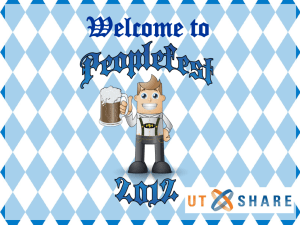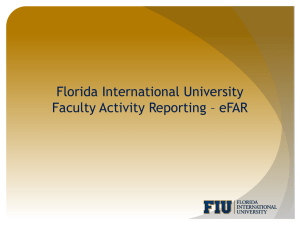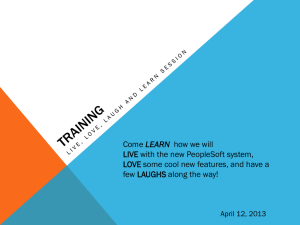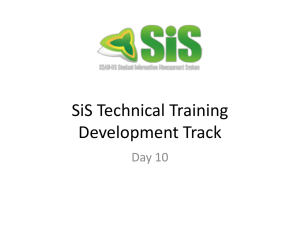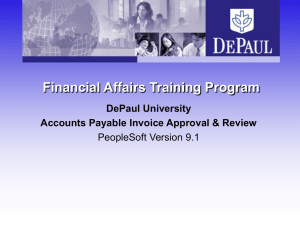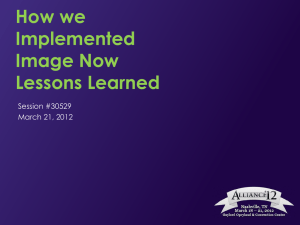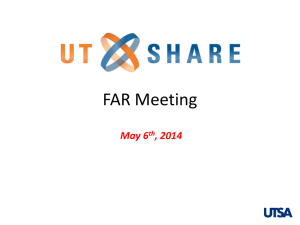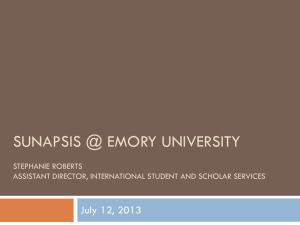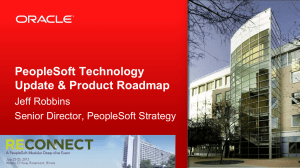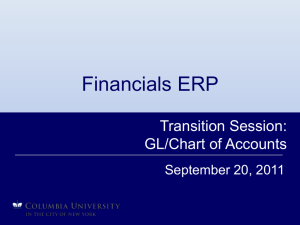PS Overview Course - Pilot 2
advertisement
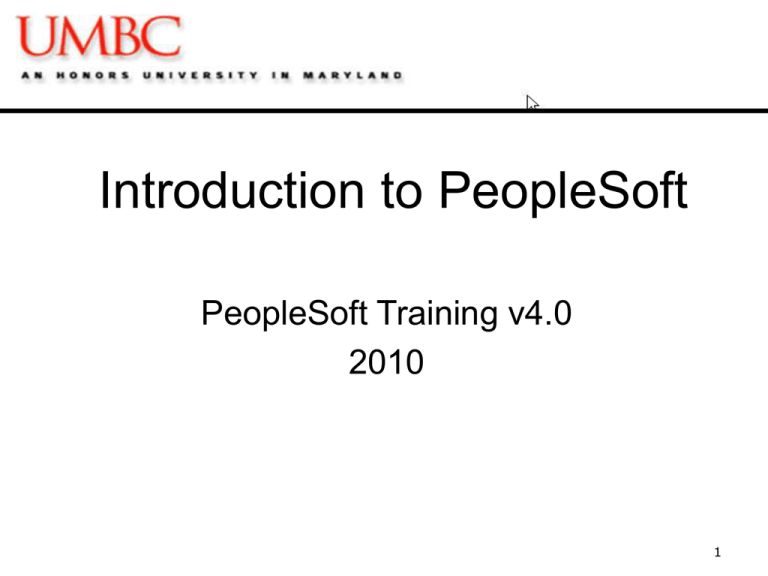
Introduction to PeopleSoft PeopleSoft Training v4.0 2010 1 Course Objectives The main objective of this course is to provide a basic introduction and overview of the PeopleSoft System as implemented by UMBC. 2 AGENDA What is PeopleSoft? How do I gain access to PeopleSoft? What is the Finance Database? What is the Campus Solutions Database? What learning resources are available to help me? 3 Module 1: What is PeopleSoft? A relational database application, which provides enterprise-wide business solutions Finance Human Resources Student Administration 4 What are the first steps? Ensure department’s payroll unit has obtained your employee ID# (10 digits) Approval of your immediate Manager Use your Employee Identification Number to obtain a UMBC Login ID, and Password. Determine what access level you will need to perform your job specific PeopleSoft responsibilities (supervisor) 5 How do I gain access to PeopleSoft? Finance Security Access Forms RT Ticket X Human Student Resources Administration X X 6 User Security Rights for Accessing Databases No Access View Only Access Edit Access 7 The Peoplesoft website 8 Where can I locate the Security Forms? 9 Why would I complete a Security Access Form? • • New hire Roles/job change: – – – remove access to areas you no longer need access gain access to areas of PeopleSoft you need for your new role change the department(s) you have access to view in PeopleSoft 10 Finance Security Access Form 11 HR Security Access Form 12 Student Administration Security Process At this time, there is no form. 1) 2) 3) 4) Open RT Ticket Indicate what module or access you need Route the ticket to Student Administration Student Administration will assign ticket to appropriate departments 13 How to register for training The I Will Attend button is located here. 14 PeopleSoft Features • Single system of record entry and reporting capabilities for all financial transactions across all UMBC units. • End-users initiate transactions and data into the system once and make it accessible for multiple purposes. (Finance, Human Resources, Reports) • Processing and tracking of transaction status is available online 15 PeopleSoft Features • Transaction approvals have been simplified. (Pcards, Purchase Orders, etc.) • Some transactions can be approved and submitted online, while meeting internal controls. • The number of signatures required for normal business processes has been reduced, while keeping in line with State policies. 16 PeopleSoft Databases Data is shared between HR and Finance PeopleSoft Finance “Campus Solutions HR / Student Administration Financial Retriever is updated from PeopleSoft Finance nightly PeopleSoft Financial Retriever and Reports 17 Finance Modules General Ledger Review Journal Entry transactions Generate various General Ledger summary or detail reports Accounts Payable Review voucher data Journal drill down Purchase Order Inquiry Review payment information for a vendor Billing Review billing information by journal ID View invoices to other parties Off-campus billing 18 Finance Modules Purchasing Requisitions Purchase Orders Receiving Procurement cards (Pcards) Review Pcard charges Allocate Pcard charges Approve Pcard charges 19 Finance Modules Projects Project activity, collect and analyze non-financial project information Grants Enter Grant Proposal View Grant award profile and project data Generate reports Effort Reporting Review and approve effort reports for grants Generate effort reports on Grants 20 Available in PeopleSoft Finance: Generate budget reports Request Requisitions Manage Requisitions Manage Purchase Orders View Pcard charges Allocate Pcard charges Reconcile your department activities Enter Grant proposals Generate Grant reports Approve Grant Effort Reports Research activity View original transactions online 21 PeopleSoft Databases Data is shared between HR and Finance PeopleSoft Finance “Campus Solutions HR / Student Administration Financial Retriever is updated from PeopleSoft Finance nightly PeopleSoft Financial Retriever and Reports 22 PeopleSoft Retriever A UMBC specific database designed to be used specifically for generating reports Comparable reports from PeopleSoft Finance, but dedicated database for efficiency Retriever may be replaced by REX / iStrategy by FY12 23 PeopleSoft Databases Data is shared between HR and Finance PeopleSoft Finance “Campus Solutions HR / Student Administration Financial Retriever is updated from PeopleSoft Finance nightly PeopleSoft Financial Retriever and Reports 24 HR Modules • Time and Attendance – Print Employee Timesheets – Enter Employee Time and Leave Taken – Review Leave balances for faculty and staff • Payroll – Processing departmental payroll – Paycheck Generation – Payroll Reporting (bi-weekly paycheck data and departmental payroll charges) – Visa and Tax Treaty tracking 25 HR Modules • HRMS – Position Management (establishing and modifying position data) – Processing New Hires – Processing Changes to employee personal and job data • Base Benefits – Track and view employee benefit plan information (health, retirement, etc.) – View leave accruals for faculty and staff – View levels of coverage and deduction information 26 HR portion of Campus Solutions • Maintaining employee personal, personnel and payroll information for electronic transmission to the State Payroll Office to generate pay for employees; • Eliminating manual efforts relating to the calculation of payroll, leave, etc. by departmental staff; • On-line tracking of HR transactions and elimination of many hard-copy documents; • Integrating/sharing payroll and job data with the PeopleSoft Finance Database 27 PeopleSoft Databases Data is shared between HR and Finance PeopleSoft Finance “Campus Solutions HR / Student Administration Financial Retriever is updated from PeopleSoft Finance nightly PeopleSoft Financial Retriever and Reports 28 Student Administration • • • • • • Recruitment Admissions Student Records Financial Aid Student Billing Academic Advisement (Degree Audit) 29 Faculty Self Service • • • • • • Teaching Schedule Class Permissions Advising Authorizations Online Grading Student Reports Advising Notes and History 30 Student Self-Service • • • • • • Register for Classes Drop a Class Swap a Class View Class Schedule View Student Reports View Grades 31 PeopleSoft Databases PeopleSoft Finance “Campus Solutions HR / Student Administration PeopleSoft Financial Retriever and Reports 32 How the HR and Finance Databases Share Information A new Chartstring is entered into the PeopleSoft Finance database, and a Program is run, which automatically moves the Chartstring to PeopleSoft HR where an Combination Code is generated. Human Resources Finance Chartstring The new Combination Code is transmitted back to the Finance Database for the posting of HR transaction data to the General Ledger. Combination Codes = Chartstring = Combination Code Funding Source 33 PeopleSoft Terms Chartfield: An informational field that aids in segregating and categorizing transactions and budgets in PeopleSoft 34 PeopleSoft Terms Chartfield String: A series of Charfields brought together (Charfield String = Chartstring) 35 How are Chartstrings used? Generate reports Access data Perform transactions in PeopleSoft Complete forms Allocate expenses 36 PeopleSoft Terms CHARTSTRING Understand purpose Understand the components Know, define and give examples Explain and give examples of how Chartstrings are used in PeopleSoft 37 Chart of Accounts Designed to meet the following objectives: • Comply with external financial reporting requirements (State, GAAP, OMB,etc.) • Improve access to financial info in support of faculty and staff • Integrate with Human Resources and Student Admin Systems 38 Comparison for Chartstring Indicates whose money you are using Indicates which entity is holding funds Date/timeline Indicates from which account to pull funds 39 Comparison for Chartstring Indicates which entity is holding funds Indicates whose money you are using Date/timeline Indicates from which account to pull funds 40 What chartfields do I need to know? What Chartfields do I need to know? There are fourteen (14) chartfields in PeopleSoft Finance. While there are fourteen chartfields that are available in PeopleSoft, not all chartfields are required for every transaction. Some chartfields are specific to grants, while others are specific to other types of transactions. Chartfields associated to General Ledger transactions are referred to as GL chartfields, and include, but are not limited to: Business Unit Department Fund Code Account Program Fin Tcode Budget Year 41 Chartstring Terminology Examples and definitions of Chartfields Chartfield Business Unit Examples (not inclusive) UMBC1 (default and only choice at this time) Department ID 10118 – New Media Fund 1111 – Current Unrest Unall SS E&G 1112 - Current Unrest Un-All SS Aux 1113 - Current UnR UnA Self Supt E&G 1253 - Curr Restr Sponsored Self Supp 1263 - Curr Restr Fin Aid Self Supp Revenue 4876000 – Misc Revenue 4876310 – Rents 4876344 – Services Income Personnel Accounts 6010101 – Regular Faculty 6010102 – Regular Exempt 6010103 – Regular Non-exempt 6010104 – Graduate Assistants/Fellows 6010111 – Contractual Faculty 6010112 – Contractual Exempt 6010113 – Contractual Non-exempt 6012000 – Student Operating Costs 7000000 – Operating Costs 7020000 - Special & Technical 7070000 - Motor Vehicles 7080000 - Contractual Services 7090000 – Supplies 7110000 - EQUIPMENT Capital or Sensitive Account (former FAS Sub-code) DEFINITION It represents a set of financial records, business practices, and reporting requirements for an independent entity. It denotes an organizational unit responsible for business transactions. The unit will have employees and usually has a budget. It identifies the source of funds. Example The default business unit for UMBC is UMBC1. E.g. English Department’s code is 10113 By default, 0000 is selected, which denotes all funds. EXAMPLES: 1111 = State Funds 1113 = Self-support (DRIF) 1253 = Grant Funds It classifies business transactions by categories that include assets, liabilities, net asset (fund balance), revenue and expenditures. Personal expenses = salary/fringes/etc Operating Costs = purchases 42 Chartstring Terminology Examples and definitions of Chartfields Chartfield Tcode Budget Year Examples (not inclusive) [412] - Expenditure Adjustment Decrease [413] - Expenditure Adjustment Inc(DR) 2006 = (7/1/05 – 6/30/06) Project/Grant i.e., 00000444 CASPR “CV” = pre PeopleSoft Grant Program OP 065 066 067 068 071 072 073 Prog Fin (Program Financial) 011 012 021 022 041 042 Supp 043 044 051 061 062 071 081 - - Summer Salaries ITT Exempt Staff Development Non-Exempt Development Academic Initiatives International Programs Reallocated Monies Instruction – General Instruction – Special Research - Institutes/Centers Research – Individual Academic Support – Library Academic Support - Comput Academic Support – Admin Academic Support – Other Student Services Institutional Supt - Gen Admin Institutional Supt - Admin Com Operation & Main of Plant-Oper Auxiliary Enterprises DEFINITION Denotes the type of transaction. The Budget Year corresponds to UMBC’s fiscal calendar and denotes a fiscal year. This Chartfield provides the link for financial transactions to the project/grants management software modules. It is an on-going, specific, regular activity or event and business transactions may cross funds, departments, and sources of funds. Operational Programs will be developed and designed for campus purposes. It is an ongoing, specific, regular activity or event and business transactions may cross funds, departments, and sources of funds. The Prog Fin further categorizes your spending! Example E.g. receipts, disbursements, adjustments, payables and receivables. Budget Year will always default to current fiscal year. Project number Grant Number Assigned to an operation unit’s normal activities. (i.e., if you typically do Instruction, but have a one time event of research, you would still use your normal Prog Fin for instruction.) A Department’s Budget has the appropriate Prog. Fin’s for a 43 Department. HR Terminology Term Job Data Personnel Data Time Entry New Hire Personnel Action Request (PAR) Change PAR Combination Code Position Management Department Budget Earnings Retro Definition Information used to identify an employee’s title, status, compensation, classification, and benefits eligibility required to generate pay for services rendered, as well as other on/off campus reporting activities. Key information outlining employee personal attributes such as name, address, race, birthplace, social security number, citizenship and visa status, veteran’s status, etc. required for University, State and Federal reporting as well as payroll taxation. Mechanism used by departments to record hourse worked, leave taken and other exceptions to employee which ultimately result in payment to the employee. Document used to gather personnel and job data for new employees. On-line mechanism used by departments to request changes to personnel and job data for existing employees. A PeopleSoft generated number used by the HR database to encapsulate the Chartfield String used in PeopleSoft Finance and identify funding source for positions/jobs. A term to describe the actions related to the classification and compensation activities within the university. Identifies how current and future payroll funds for a position are to be distributed financially across fund sources. Refers to the Retroactive Change Form, which is used to modify how payroll was distributed 44 historically. Finance Terminology Term General Ledger Definition The final ledger in the financial system which holds all financial transactions used for external and summary financial reporting and financial management. Commitment Control Finances that have been reserved for a specific financial transaction, prior to final approval and posting to the General Ledger. P-card Procurement Card – similar to a credit card used for purchases Project An event or activity that has a specific beginning and end date. Grants/Contract Money awarded to departments by a Sponsor for the purpose of providing products and/or services for a specific project. State Funded Money appropriated to UMBC by the State of for the purpose of administering education services to students. Retriever Inquiry A reporting tool designed specifically for UMBC to generate state funded budget reports. Retriever Pre-encumbrance The UMBC Finance Reporting Instance Money requested to be used for a specific purpose – a Requisition. Encumbrance Money approved and reserved to be used for a specific purpose – a Purchase Order. Journal Entry Journal ID Adjustment made directly in the General Ledger Transaction identification number used to identify Journal Entries. This number appears on budget detail reports and is used to research 45 budget line item details. Requesting Help • Include the Database you are using, i.e., Finance, HR, Retriever and Reporting Instance; • Include EXACTLY what you are trying to do in PeopleSoft, and what happened when you performed the task; • State your PeopleSoft experience (i.e., new to PeopleSoft, using for 6 months, etc), • State for what purpose you were performing the task in PeopleSoft (i.e., to retrieve monthly operating expenses for my State budget). • State the best way to reach you, and during what hours you can be reached. 46 Questions ?’s 47
